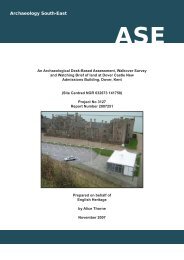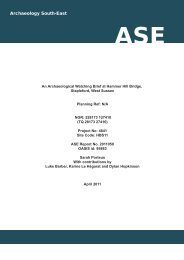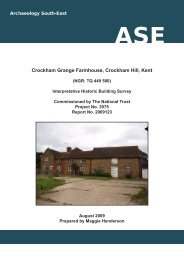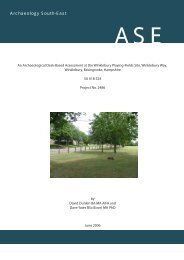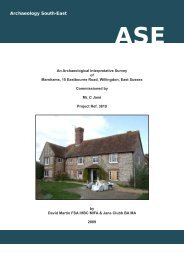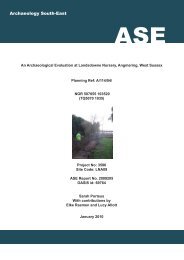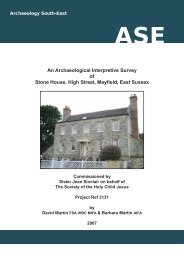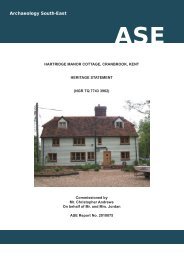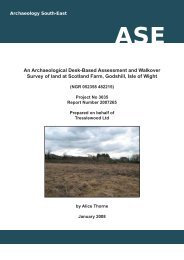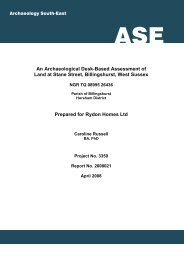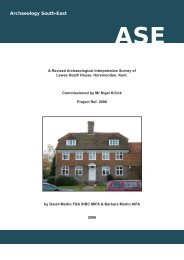ASE front cover - Archaeology South-East
ASE front cover - Archaeology South-East
ASE front cover - Archaeology South-East
Create successful ePaper yourself
Turn your PDF publications into a flip-book with our unique Google optimized e-Paper software.
<strong>Archaeology</strong> <strong>South</strong>-<strong>East</strong>2008058: Holbury Infants School, Holbury, Hampshire5.4.2 All of the pieces are well preserved showing no clear evidence of decay.One of the larger pieces, identified as Oak (Quercus sp.), has severalpossible cut marks at right angles to its length. However these may resultfrom excavation as none of the pieces are deliberately shaped and no otherevidence for working is apparent. One of the smaller pieces includes knotwoodand two other specimens display twisted wood that develops aroundknots. They may all originate from a single larger timber. Unfortunately thepieces do not retain any sapwood (preferable for dating oak) so are notsuitable for dendrochronological dating.ContextNumber1023Specimennumber1234NotesTable 8: Details of waterlogged wood55 x 8 x 4.5cm. Well preserved, no sapwood,some possible cuts at right angles to itslength.18 x 5 x 4cm Well preserved, no sapwood,specimen is twisted and includes knot wood,no working is evident16 x 4 x 4cm Well preserved, no sapwood,specimen is twisted and includes knot wood,no working is evident51 x 13 x 9 cm Well preserved, no sapwood,specimen includes some knot wood, noworking is evidentIdentificationOak - Quercus sp.---5.5 IronworkElke Raemen5.5.1 The ironwork consists mainly of nail fragments. All of these are heavilycorroded with corrosion products and stones adhering to them. Due to thefragmentary nature and poor condition, no typology can be made. A total of21 general purpose nail fragments were re<strong>cover</strong>ed, most of which are shankfragments. Five heavy duty nails were re<strong>cover</strong>ed from two differentcontexts, [1058] and [1107] both fills of possible hearth [1057]. In addition,two strip fragments were re<strong>cover</strong>ed: one from possible hearth [1057] within[1058] and one from probable quarry pit [1004] within [1006].5.6 Burnt ClayElke Raemen5.6.1 Three fabric types can be distinguished over a total of 22 pieces from ninedifferent contexts. These fabrics are described below:Fabric type 1Sparse fine sand-tempering, occasionally with rare inclusions of clay pelletsto 3 mm, or angular flint inclusions to 3 mm, or rare iron oxide inclusions to 2mm.Fabric type 2Sparse fine sand-tempering with rare to occasional clay pellets to 2 mm andrare to occasional iron oxide inclusions to 3 mm.30© <strong>Archaeology</strong> <strong>South</strong>-<strong>East</strong>



